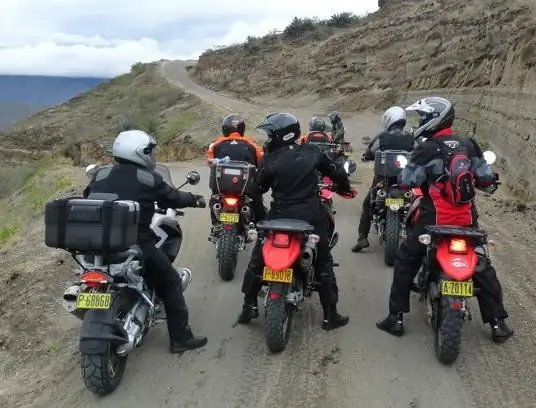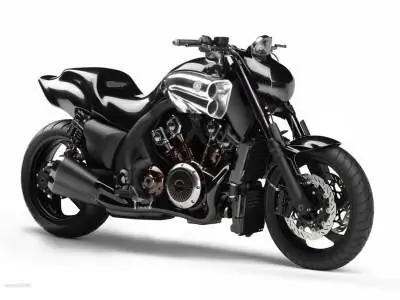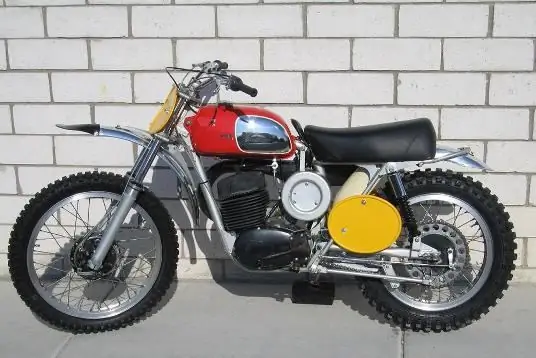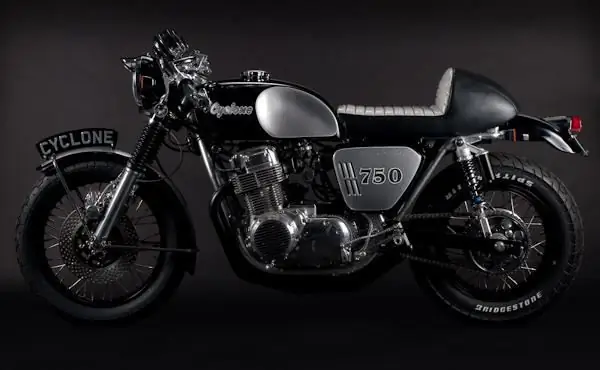2025 Author: Erin Ralphs | [email protected]. Last modified: 2025-01-22 21:14:11
At the end of the 30s of the 20th century, a meeting was held in the People's Commissariat of Defense of the USSR, the main topic of which was the analysis of new types of military equipment, and the prospects for adopting the best of them into service with the Red Army. One of the types of equipment that the Red Army badly needed was an army motorcycle. After analyzing the samples, the motorcycle of the German company BMW - R71 turned out to be the best.
By that time, he had been in service with the Wehrmacht for several years. It was decided to take this car as the basis for a new motorcycle. The development of the domestic version of the R71, which received the designation M72, took several years. Therefore, the serial production of the domestic motorcycle began shortly before the war - in the spring of 1941. Production mastered at the Moscow Motorcycle Plant (MMZ).
But due to the rapid advance of the Germans on Moscow, by the end of October 1941, the plant was evacuated to the city of Irbit. The territory of the former brewery was provided as a site for the plant. The new enterprise became known as IMZ (Irbit Motorcycle Plant). Serial production of the M72 IMZ began at the end of 1941.

M72 was originally equipped with a lower valve engine, which even at the time of the creation of the machine had little room for improvement. This circumstance spurred the IMZ designers to create a new overhead valve engine. This device went into production in 1957. A transitional motorcycle equipped with such an engine was designated M61. Motorcycles M72M and M61 were produced in parallel until 1960.
Since 1961, simultaneously with the assembly of the now old M61 model, the production of the new Ural M62 model began. The motorcycle was delivered complete with a sidecar. This stroller was single and equipped with a luggage compartment located behind the back of the seat. The stroller was attached to the motorcycle frame with the help of collet hinges and extensions at four points. The wheel of the carriage had a lever suspension with a shock absorber. Suspension travel - up to 120 mm. The spare wheel was mounted on the lid of the luggage compartment of the stroller. The general appearance of the Ural M62 motorcycle can be seen in the photo below.

M62 engine
The Ural M62 motorcycle was equipped with a four-stroke, carbureted, two-cylinder engine with an opposed cylinder arrangement. The engine had an overhead valve gas distribution system and traditional air cooling. The cylinder diameter was 78 mm, the piston stroke was 68 mm, the engine displacement was 649 cc.
Thanks to improvements in design and an increase in the compression ratio to 6.2, the power of the M62 engine has increased. Compared withpredecessor, it increased by 2 liters. With. and was 20.6 kW (28 hp). Maximum power was achieved at 4,800-5,200 rpm of the crankshaft. The torque also increased, which was quite good for those times 41.8 N / m at 3,500 rpm.

The engine cylinders were made from high-alloy cast iron, the right and left cylinders were completely interchangeable. The engine was equipped with aluminum cylinder heads and two overhead valves per cylinder. Combustion chambers - hemispherical. The valves were suspended on two coil springs.
This solution, together with ceramic-metal valve guides in the cylinder heads, ensured valve operation without sticking and rapid wear, and also significantly increased their reliability. Due to the increased power, the M62 engine received reinforced pistons. Each piston had four piston rings - two compression and two oil scraper. The upper compression ring had a porous chrome plating, which made it possible to ensure reliable lubrication of the cylinder mirror and, accordingly, increase the mileage before overhaul.
A more advanced engine had more liter capacity, which also increased the dynamic properties of the motorcycle. It should be noted that a decrease in the working volume of the engine and the transition to an overhead valve gas distribution scheme significantly reduced the metal consumption of the structure, which in turn reduced the weight of the motorcycle. According to various sources, the maximum speed reached 95-100 km / h (with a sidecar),at control fuel consumption - 5.8-6 l / 100 km (at a speed of 75% of the maximum).

M62 engine power and lubrication system
So, we continue to further consider the characteristics of the Ural M62. Its power system included two K-38 carburetors, mesh fuel filters in the gas cock sump and in the gas tank neck. The capacity of the fuel tank was 22 liters. The air filter is combined, inertial and contact-oil with two-stage cleaning. Air filter filling capacity - 0.2 l.
Standard lubrication system, combined - under pressure from the oil pump and spray. Engine crankcase capacity - 2 liters.
Electrical equipment М62
The Ural M62 motorcycle was equipped with a 6 volt electrical system. The current sources were a 3MT-12 battery and a G-414 DC generator with a power of 60 W (on the earliest versions of the G65), which worked in tandem with a RR-302 relay-regulator. The ignition system included an ignition coil model B-201 and an ignition interrupter PM-05.
The breaker was equipped with a centrifugal ignition timing device. New components in the ignition system made it possible to automatically set the engine to the optimum operating mode, which improved the motorcycle's dynamic performance while reducing fuel consumption.
Transmission M62
Due to the increased torque characteristics, the clutch discs received a reinforcing coating from the friction material KF-3, which was new at that time. The new raw material had a highwear resistance combined with a high coefficient of friction.
The bike has received a completely new four-speed gearbox model 6204 with a small spline shift mechanism. The filling capacity of the gearbox housing is 0.8 liters. The new box was largely spared from the defects of the M72 gearbox. The reverse gear, traditional for IMZ motorcycles, has also undergone changes, consisting of a cardan shaft and a rear wheel gearbox.
The driveshaft connection became splined, and the crosspiece received needle bearings instead of bronze bushings. The main gear (GP) of the motorcycle consisted of a pair of bevel gears with a spiral tooth. Gear ratio - GP 4, 62, oil volume in the crankcase - 0.15 liters.
Pendant M62
In addition, the IMZ designers managed to significantly improve the comfort of the motorcycle, especially when driving off-road. A huge role in this was played by the increase in travel of the front telescopic and rear linkage forks, equipped with more advanced shock absorbers on the front and rear forks. Suspension travel has grown to 80mm for the front and 60mm for the rear. The tubular double frame of the motorcycle was structurally almost unchanged and was made by welding.
M62 brake system
The increased dynamics of the Ural M62 required the installation of reinforced wheels with aluminum brake drums with an increased braking area. The drums received a labyrinth seal that prevents dirt and sand from getting inside. This innovation significantly increased reliability and service life.brake mechanisms. The 3.75-19 wheels were interchangeable and mounted on adjustable tapered bearings.
M62 controls
To improve the driver's seat, the steering wheel geometry was changed and the driver's saddle was equipped with a rubber damping element. In addition, a two-cable “gas” handle, new front brake and clutch levers are new. Other motorcycle control mechanisms have become more convenient and reliable in operation.

| Max load | 255kg |
| Mass (dry) | 340kg |
| Length | 2 420mm |
| Width | 1 650mm |
| Height | 1,000 mm |
| Base, mm | 1 435mm |
| Ground clearance | 125mm |
| Track | 1 140mm |
| Max speed | 95…100 km/h |
| Control fuel consumption | 5, 8…6, 0 l/100 km |
Our days
The production of the Ural M62 motorcycle continued until 1965. Then he was replaced by a new model - M63. To date, Ural M62 motorcycles have become a fairly rare car, although you can still find samples in almost original condition. Such motorcycles are readily purchased by lovers of old motorcycles both for restoration in a completely original form, and for creating retro choppers based on them.
Recommended:
Touring motorcycles. Characteristics of motorcycles. The best touring bikes

Two-wheeled transport allows you to make long journeys. Modern touring motorcycles make it possible to do this easily and comfortably. Now a new type of tourism is emerging and developing - motorcycle travel
Motorcycle: types. Classic and sports motorcycles. Motorcycles of the world

Sport bikes differ from their classic counterparts in lightness and high speed. As a rule, all sportbikes are racing. By classic, they mean a regular motorcycle that serves for short and long trips
Motorcycles 250cc. Motocross motorcycles: prices. Japanese motorcycles 250cc

250cc motorcycles are the most popular models in the road class. Various modifications of the brands "IZH", "Kovrovets", "Minsk" can still be found today both on the highway and on city streets
The best classic motorcycles. Road classic motorcycles

An article about classic road bikes, manufacturers, etc. The article provides buying advice and talks about the permanence of the classics
Soviet motorcycles. Motorcycles of the USSR (photo)

The history of the domestic motorcycle industry is an integral and bright part of the global production of bikes. Izhevsk, Kyiv, Minsk and Kovrov factories can boast both famous victories and bitter defeats. Ultimately, the entire production of Soviet "iron horses" ended in complete oblivion

